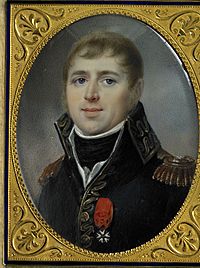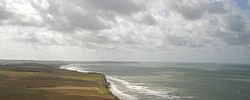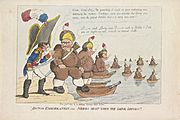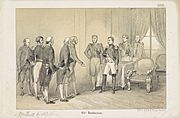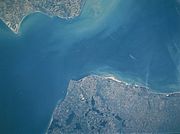Battle of Blanc-Nez and Gris-Nez facts for kids
Quick facts for kids Battle of Gris-Nez and Blanc-Nez |
|||||||
|---|---|---|---|---|---|---|---|
| Part of Napoleon's planned invasion of the United Kingdom during the War of the Third Coalition | |||||||
 The Battle of Gris-Nez and Blanc-Nez, 18 July 1805 by Martinus Schouman |
|||||||
|
|||||||
| Belligerents | |||||||
|
|||||||
| Commanders and leaders | |||||||
| Strength | |||||||
|
21 Batavian gunboats Several French artillery pieces on shore |
45 warships At least 900 guns in total |
||||||
| Casualties and losses | |||||||
| 10 killed 60 wounded 16 killed 70 wounded |
unknown killed 260 wounded. |
||||||
The Battle of Gris-Nez and Blanc-Nez was a sea battle fought on July 18, 1805. It took place between a combined fleet of ships from the Batavian Republic (which was the Netherlands at the time) and France, led by Carel Hendrik Ver Huell, and a larger British fleet, led by Lord Keith. This battle was part of the Napoleonic Wars (1803–1815). The Batavian-French fleet managed to push back the British ships. They successfully reached Boulogne-sur-Mer, a key port in France.
Contents
Preparing for Battle: The Invasion Plan
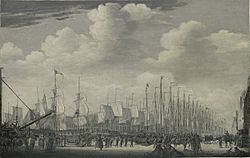

The Batavian Navy was meant to help Napoleon invade the United Kingdom. For this plan, many flat-bottomed boats were built in the Batavian Republic. These boats needed to be moved by sea to Boulogne. Boulogne was the main starting point for the invasion.
Ver Huell's Important Role
Carel Hendrik Ver Huell was chosen to lead this risky mission. He was a vice-admiral, a high-ranking naval officer. In 1804, Ver Huell had already moved a large Batavian fleet from Vlissingen to Dunkirk successfully. A British fleet, led by Sir William Sidney Smith, tried to stop him near Ostend. However, Ver Huell's excellent sailing skills and French cannons on shore forced Smith to retreat.
Napoleon was very impressed by Ver Huell's success. He even wrote to Ver Huell, praising him. Ver Huell became the first non-French person to join the Légion d'honneur. This was a very important award given by Napoleon. The Batavian government also made him vice-admiral and minister of the navy. He was also put in charge of the right side of the Flottille de Boulogne. This was a big fleet meant to invade Britain.
First Encounters at Sea
Ver Huell received orders to sail his fleet from Dunkirk to Ambleteuse. This port was close to Boulogne. On July 17, 1805, Ver Huell set sail. He had 4 French prams (flat-bottomed boats) and 32 Batavian gunboats (small boats with cannons). A British fleet of 15 warships attacked them nearby.
After a tough fight, the Batavian fleet, again helped by French cannons on shore, pushed back the British. Around 11:00 AM, the British had to leave. However, this battle forced Ver Huell's fleet to stop at the port of Calais. Other Batavian ships from Dunkirk then joined them safely.
The next morning, Ver Huell's fleet was attacked again. This time, 19 British ships attacked. These included two large ships of the line, some frigates (medium warships), corvettes (smaller warships), and bomb galiots (ships that fired bombs). The British had to retreat quickly. But Ver Huell had to leave some ships behind for repairs.
The Main Battle
On July 18, at 3:00 PM, Ver Huell's fleet finally left Calais. It now had 21 gunboats, 3 prams, and 180 cannons. Louis Nicolas Davout, a French general, joined as an observer. Ver Huell was on his ship, the Heemskerk.
Facing a Stronger Enemy
Around 5:00 PM, Ver Huell's fleet met the British fleet. This happened between Cap Blanc-Nez and Cap Gris Nez. The British fleet was much stronger. It had 45 warships and 900 cannons. Just as Ver Huell sailed around Blanc-Nez, the French cannons on land could no longer reach his ships. This left his fleet without shore support.
The British fleet was waiting for the Batavians. They had many more cannons and ships than Ver Huell's group. The British started firing heavily. Several British ships got close to the Batavian fleet. But they were pushed back. The British could not stop Ver Huell's fleet from moving towards Gris Nez.
A Risky Maneuver
To get around the tip of Gris Nez, Ver Huell's ships had to move further out to sea. This put them in easy range of the British ships. The British could now aim their cannons from a very short distance. Also, every ship had to pass this point, making them targets for the entire enemy force.
However, the Batavian ships were low in the water. This made them harder targets for the British cannons. The larger British warships, on the other hand, were much easier to hit.
Despite the heavy firing, Ver Huell's group reached Gris Nez in good order. The British then gathered their forces. They aimed at the spot where every Batavian ship had to pass. The whole British fleet took a position a short distance from the cape.
One part of the British fleet tried to surround the Batavian vanguard (the leading part of the fleet). Another part shot at the Batavian fleet from the side. They tried to cut off its path.
Ver Huell's Success
Even with all the enemy fire, the first gunboat, with Ver Huell on board, sailed around the cape safely. Ver Huell had made sure his fleet stayed in a very tight formation. This meant the British could not break through it. The British plan failed. The Batavian fleet reached the coast safely. They finally stopped between Audresselles and Ambleteuse.
The British launched one last attack on the Batavian gunboats. But the French coastal cannons, now in range, fired back. They forced the British ships to head back out to sea. Around 8:00 PM, the battle was over.
After the Battle
After this trip around Cape Gris Nez, another Batavian fleet of 84 ships also made it safely. They traveled from Dunkirk to Ambleteuse without harm. Ver Huell received much praise in France for his success.
However, in the Batavian Republic, the victory was not celebrated much. Despite this brave achievement, other events happened elsewhere. Because of these, the plan to invade Britain was eventually called off.
Gallery
Sources


